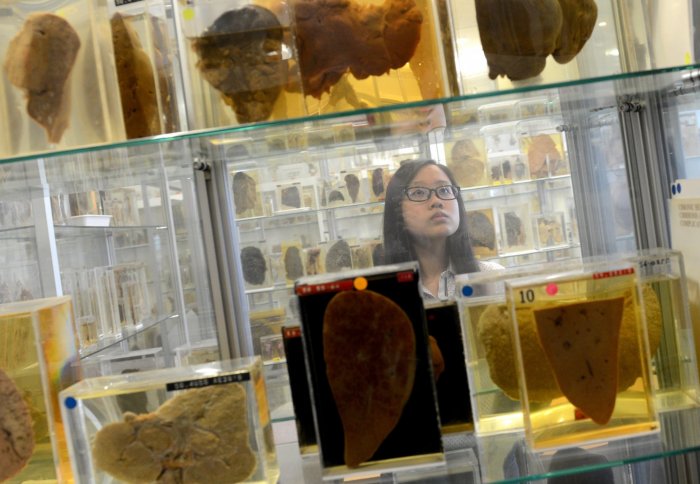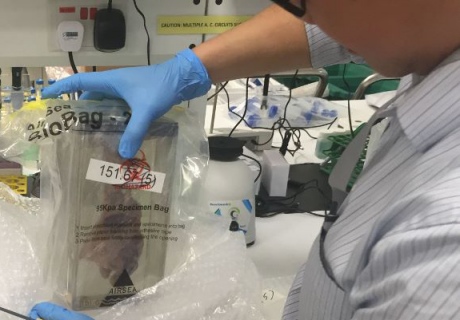

Medical students in Singapore have received a gift of a most unusual kind: human pathology and anatomy specimens, donated by Imperial College London.
Imperial College London’s Pathology Museum has gifted more than 180 human anatomical and pathological specimens to the Lee Kong Chian School of Medicine (LKCMedicine) in Singapore in benefit of medical education there.
Each carefully wrapped in protective film, the specimens are surgical resections and post-mortem specimens from the collections of Imperial’s former constituent medical schools—making for a donation of a unique logistical challenge.
We hope that this collection proves to be as beneficial to the students at LKCMedicine as our museum collection is to the students in London.
– Dr Mike Barrett
Head of Learning Resources in the School of Medicine
The recipient LKCMedicine opened as a collaboration between Singapore’s Nanyang Technological University and Imperial College London in 2013, and the gifted specimens will be housed in a new building at LKCMedicine’s Novena campus as the establishment of its own collection.
The exhibits come from Imperial’s Pathology Museum, curated by the Human Anatomy Unit, which boasts a collection of tissue specimens dating back to 1888 that support both undergraduate and postgraduate medical education.
But with display space for only around 2,500 pathological specimens, many exhibits remain hidden in storage. That’s why, early in the collaboration period between Imperial and LKCMedicine, the anatomy curriculum leads from London and Singapore visited the museum to select specimens that would augment both the anatomy and, later, the pathology teaching at LKCMedicine.
LKCMedicine provides its students the very latest learning technology, including an Anatomage Table which displays life-sized 3D images of full body anatomy. Anatomical specimens, however, have been studied for medical knowledge for hundreds of years, and this donation will supplement the modern anatomy resources available to LKCMedicine students like ultrasound, plastinated specimens and the Anatomage Table.
An initial selection of around 180 specimens was made, although there are many more that could have been included. All specimens have a full description of the pathology and are classified using standard international tissue and disease nomenclature. For some, histological material is also provided.

LKCMedicine laboratory assistant manager Darren Lim unpacks the first container on 7 March 2016
Logistical challenges
Being a historical collection from many institutions, the specimens are in a variety of display containers (pots)—glass and plastic, square and cylindrical, each preserved in conservation fluid—which presented unique challenges for the Human Anatomy Unit in cataloguing and shipping the exhibits.
The decision was taken to delay sending the pots until the new building at LKCMedicine’s Novena campus was near completion. With the building now nearly finished, Rachael Waddington, Manager of the Human Anatomy Unit, and her team set to work.
Dr Mike Barrett, Head of Learning Resources in the School of Medicine, explains the process.
“Removal of the conservation fluid prior to transport would have reduced transport costs, but it could have resulted in damage to delicate specimens,” he says. “Thus the decision was made to transport the pots intact. Protective foam-lined crates were provided by the couriers and each pot was plastic film wrapped and bagged beforehand.
“We also had to get the Singapore Ministry of Health’s approval to import the specimens. After reviewing the methods of preservation of the specimens and the nature of their containment, the ministry found that they presented no health risk and so permitted the importation. As a confidence test, two specimens were airfreighted to Singapore last December to test out processes, and they arrived intact!
“It has been a big undertaking cataloguing and packing the specimens, but with the great support of the Human Anatomy Unit, we waved the specimens off at the beginning of March. LKCMedicine laboratory assistant manager Darren Lim received them in Singapore and is now organising for them to be re-potted into brand new display cases ready to be put on view.
“We hope that this collection proves to be as beneficial to the students at LKCMedicine as our museum collection is to the students in London.”
Article text (excluding photos or graphics) available under an Attribution-NonCommercial-ShareAlike Creative Commons license.
Photos and graphics subject to third party copyright used with permission or © Imperial College London.
Reporter
Ben Campion
Faculty of Medicine Centre

Contact details
Email: press.office@imperial.ac.uk
Show all stories by this author



